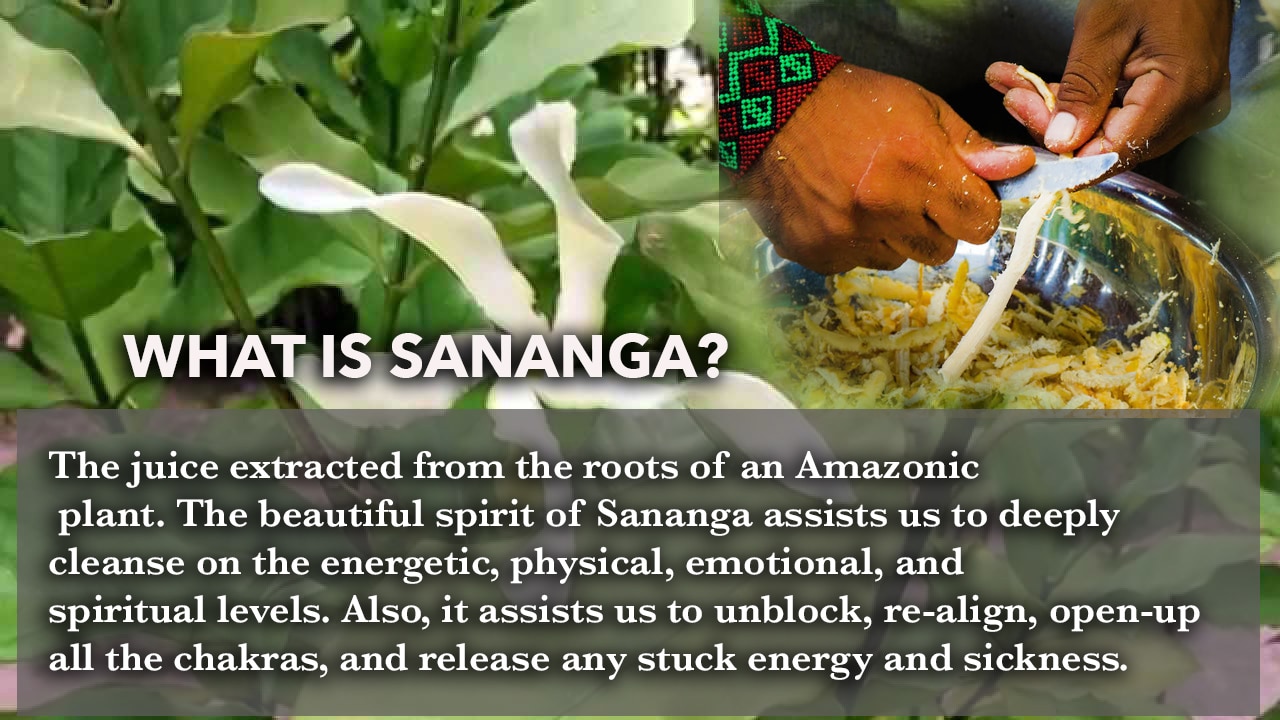Forest Teacher Plants
Benefits of the Sananga Eye Drop
Sananga Eye Drops
Sananga is the juice extracted from the roots of an Amazonian plant, whose indigenous name is Mata Heins, a name that comes from the Huni Kuin dialect, spoken by the Kaxinawas. It is a bush tree from the amazon region, utilized by the Kaxinawa Indians and other tribes.
From inside its roots, a juice is extracted, which is utilized to cure the Panemas (spiritual diseases) according to the tribes.
Its active principle is Ibogaine, a powerful substance which if ingested will take the tribes person to a state of deep trance to get in touch with spirit world.
In traditional medicine however, Sananga is utilized as an healing eye drop.
The warrior Indians, before going hunting, will take a drop in each eye, making their perception sharpened, so they can perceive subtle movements in the dense forest.
The Kaxinawa explain that Sananga works in two main energetic healing ways: Physical and Spiritual.
It is believed that the “Spirit of Sananga”; the energy, the intelligence, that analog to the active principle of this powerful plant, acts directly in the original cause of the disease, in the so-called psychosomatic processes.
The psychosomatic illnesses are of psychic origins, but as they are potentialized they are manifested in the Soma, or the physical body.
The eyes are the windows of the soul, where all that we see and all that we project is stored, including our Karmic History. The Spirit of Sananga makes a kind of verification of the energetic patterns that are out of balance, and it goes on diluting these forces that constitute the Panemas.
The result of this application is a balancing of the soul, synchronized with this spiritual force of nature, an expansion of the force of the spiritual vision, or of the AJNA CHAKRA, the third vision, the inner vision, and also an improvement in the ocular physiology.
Sananga is indicated in cases of diseases such as: Glaucoma, cataract, near and farsightedness, dystrophies, color alterations, among others.
There are cases of people who are healed of nearsightedness with one application, and there have been improvements of the perception of colors immediately.
Sananga has been explored by many but it is really important to always remember its correct form of utilization is inside of a work for spiritual evolution, because used outside of it, it can cause problems to the life of a person.
Recommended application: 1-3 drops in each eye.
The person will feel a strong vibration, where several degrees of burning may occur according to the spiritual state of a person. With time, the person will align him/herself to the spirit of Sananga and will feel less burning, when his or her vision will already have had an immense gain.
After the burning, which lasts about 3 minutes, colors will become sharper and there are visible improvements to the standards of vision.
Many treatments are miraculous, immediate, while some others occur long term, but not less miraculous.
It’s a different experience, unique, of transformation, spiritually and in the vision of a person. In a broader sense of the word.
Does Sananga Correct Eye Sight Problems?
Sananga doesn’t physically correct eye problems, but repairs such infirmities energetically, as we understand that all disease is psychosomatic, being born first in the feelings and emotions of the person and then it starts to influence the energetic layer of the organ in question and manifesting itself in the material body.
Thus, when applied, Sananga dilutes the thought forms and negative, disharmonious energies that envelop the energetic body of the eye, thus opening the energetic channels of the human being for the Inner vision, the outer vision and the Higher Vision. From the region of the head descends then a subtle energy which is favorable to maintain the Chakras open, expanding the aura and maintaining the person aligned and centered emotionally, mentally and spiritually.
For the ancestral Xamans, Panema is a conglomerate of lower energies
that stay present in the energetic body of the person, accumulated through a sedentary, negative life full of bad habits and thoughts that are harmful for the physical, emotional, mental and spiritual health of a person, that weigh heavily in the energetic body of the individual, making him or her sad, depressed, stressed physically and mentally, making it impossible that the person finds success in relationships, work and life goals. Through the Sananga this energetic charge is automatically eliminated, it’s as if the person went through an energetic shock, in a subtle way, making the person feel capable, happy, invigorated after the application.
It is recommended for people of all ages and gender. The sooner a person receives the Sananga, less problems of the ocular and vision type they will have.
Click Here to Buy Sananga Now
Common Questions about Sananga:
Is there any scientific research on Sananga?
Scientific research on sananga is currently limited, but some studies have started to explore its potential benefits. Initial findings suggest that the Tabernaemontana plant, from which sananga is derived, may possess anti-inflammatory and antioxidant properties that could be beneficial for eye health. However, it is important to note that these studies are still in the preliminary stages. To establish concrete evidence and confirm these initial findings, further research using rigorous, controlled trials is necessary.
Is Sananga considered to be psychoactive?
Sananga is not typically classified as a psychoactive substance. While it does cause a stinging or burning sensation in the eyes upon application, it is not known to induce any significant changes in perception or behavior. However, it is worth noting that some individuals have reported experiencing heightened sensory perception and spiritual experiences following the use of Sananga. These effects, though subjective and anecdotal, suggest that Sananga may have some potential for altering consciousness. Overall, the consensus is that Sananga is not traditionally considered to be psychoactive, but individual experiences may vary.
What is the best time to use Sananga?
The optimal timing to use Sananga is when you can allocate a uninterrupted period of 20-30 minutes without any disruptions. It is crucial to have a tranquil environment to fully embrace the effects of Sananga. Additionally, allowing yourself to rest and relax after using Sananga and taking time to reflect on your experience is an essential part of integrating its effects.
Can Sananga eye drops be used every day?
Sananga eye drops can indeed be used every day. However, it is important to note that different strengths of Sananga exist. A strong Sananga can be used once a day, while a lighter Sananga can be used more frequently. It is generally advisable to take short breaks from using Sananga to prevent the body from becoming accustomed to its benefits and to allow for proper integration. By incorporating these breaks into your routine, you can continue to experience the full benefits of Sananga on a daily basis.
Which type of Sananga should be chosen for optimal use?
“For optimal use of our products, it is recommended to begin your journey with our Soothing Sananga. This introductory product allows you to ease into the experience and become familiar with its effects. Once you feel comfortable with the soothing qualities, you can progress to our Balanced Sananga. This medium-strength product provides a more balanced and nuanced experience. As you continue to acclimate to the effects of Sananga, you can then consider transitioning to our Powerful Sananga. This advanced product offers a stronger and more intense experience, allowing you to fully explore the depths of its potential benefits. By following this gradual approach, your body can confidently adapt to the distinctive characteristics of each product, maximizing their effectiveness and optimizing your overall Sananga experience.”
Where can Sananga eye drops be sourced from?
Sananga eye drops can be sourced from Acre, Brazil, where they are skillfully produced by experienced practitioners belonging to the indigenous tribes of Katukina, Kuntanawa, and Yawanaw?. These indigenous individuals possess a profound understanding of herbal medicine and have honed their abilities to utilize the physical and therapeutic properties of plants. By leveraging their extensive knowledge and expertise, they infuse the Sananga eye drops with their wisdom, making it an integral part of the healing process. We firmly support these traditional practitioners and are committed to preserving their rich culture. Therefore, it is crucial to carefully consider the background and credibility of your Sananga eye drops provider to ensure an authentic and beneficial experience.
How often can Sananga eye drops be applied?
Sananga eye drops can be applied intermittently with breaks in between for better results. An effective approach is to use the drops five days a week or alternatively, for three consecutive weeks followed by a week off. It is important to have these rest periods to allow your body and mind to integrate the effects of Sananga. It is recommended to limit the usage to a maximum of once per day, unless you are using the Soothing variety of Sananga. Taking these guidelines into consideration will help you determine the frequency at which you can apply Sananga eye drops for your personal needs.
What are the common post-Sananga care instructions?
Common post-Sananga care instructions include being mindful of possible increased sensitivity to light and noise, a temporary effect that can be quite noticeable. It is advised to rest in a dimly lit and quiet room until one feels comfortable with brighter light and normal noise levels. This may help in alleviating potential discomfort such as the perception of natural light as overly bright or experiencing a mild headache. Taking the time to gradually acclimate to the surroundings can help in adjusting back to normal light and noise sensitivity.
Is it recommended to express gratitude and offer prayers after using Sananga?
Yes, it is highly recommended to express gratitude and offer prayers after using Sananga. Doing so is considered beneficial and is a common practice associated with the use of Sananga. Expressing gratitude to the higher powers is seen as an acknowledgment of the wisdom and guidance received through the experience with this plant medicine. Additionally, offering prayers of gratitude to the people and plants involved in the creation and preparation of Sananga is a way to recognize their contributions and show respect for their teachings and the healing properties of the plant. By expressing gratitude and offering prayers, one can cultivate a sense of appreciation and deepen their connection to the spiritual and medicinal aspects of Sananga.
How can one work with their breath during the Sananga ritual?
What should individuals with concerns or underlying eye conditions do?
If you have any concerns or underlying eye conditions, it is strongly recommended to consult an ophthalmologist or healthcare professional to evaluate the suitability of Sananga for your specific situation.
How do individual reactions to Sananga vary?
Individual reactions to Sananga may vary.
What are the potential risks and side effects of using Sananga?
The use of Sananga typically results in a strong stinging or burning sensation, which can be uncomfortable but is usually temporary.
Several scientific studies conducted since the 1970s have provided evidence for the pharmacological properties of shrubs belonging to the Tabernaemontana genus, including Sananga. These studies have explored the potential of these plants in fostering healthy vision and treating various health conditions.
A study from the 1990s focused on medicinal plants in Ecuador and found that a specific species of Sananga demonstrated anti-inflammatory properties. This finding supports the idea that Sananga could be an effective treatment for conditions such as arthritis, which involve inflammation.
Additionally, a study conducted in 2007 investigated the antimicrobial properties of Sananga. The results indicated that Sananga exhibited efficacy in treating skin infections. This suggests that Sananga may possess beneficial properties that can help combat microbial infections.
These scientific studies provide valuable insights into the potential pharmacological properties of Tabernaemontana genus shrubs, particularly Sananga. By demonstrating anti-inflammatory and antimicrobial effects, these studies contribute to the understanding of Sananga’s potential as a therapeutic agent.
Several scientific studies conducted since the 1970s have provided evidence for the pharmacological properties of shrubs belonging to the Tabernaemontana genus, including Sananga. These studies have explored the potential of these plants in fostering healthy vision and treating various health conditions.
A study from the 1990s focused on medicinal plants in Ecuador and found that a specific species of Sananga demonstrated anti-inflammatory properties. This finding supports the idea that Sananga could be an effective treatment for conditions such as arthritis, which involve inflammation.
Additionally, a study conducted in 2007 investigated the antimicrobial properties of Sananga. The results indicated that Sananga exhibited efficacy in treating skin infections. This suggests that Sananga may possess beneficial properties that can help combat microbial infections.
These scientific studies provide valuable insights into the potential pharmacological properties of Tabernaemontana genus shrubs, particularly Sananga. By demonstrating anti-inflammatory and antimicrobial effects, these studies contribute to the understanding of Sananga’s potential as a therapeutic agent.


